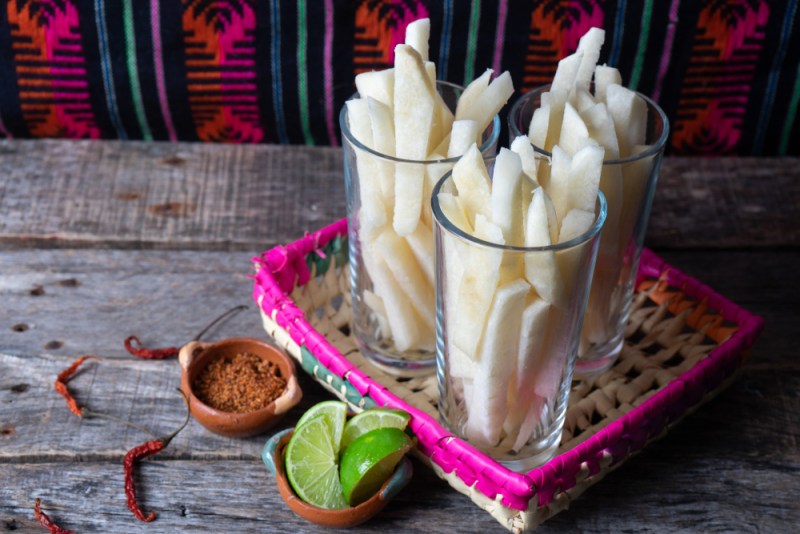Jicama, pronounced HEE-kah-ma, is a mildly flavored root vegetable that originated in Mexico and Central America. There, the tuber is often served raw with a squeeze of lime and a sprinkle of chile powder, such as Tajín Clásico. Here in the US, the keto-friendly veggie is building a reputation as a fiber-rich powerhouse of digestive benefits. Let’s get acquainted with healthy jicama and find out how the heck to prepare it.
Nicknames

Jicama by any other name tastes as starchy sweet, which is good since this root veg has many monikers. Sometimes referred to as a Mexican turnip, Mexican potato, or sweet turnip, jicama is actually part of the bean family and is often called a yam bean. Although the name most commonly refers to the edible portion—its tuberous root—jicama is actually the name of the plant’s vine. In fact, the root is the only edible part of the plant. It’s stems, leaves, and seeds contain the organic toxin rotenone.
What Does Jicama Look and Taste Like?

Jicama is a taproot. Its round shape resembles rutabaga, but its tough skin kind of looks like a brown paper bag or the skin of ginger root. When it’s peeled back, it reveals a white interior that’s as crispy and crunchy as a potato, apple, or water chestnut. It is quite fibrous, but that’s what makes it so satisfying. Jicama is starchy like a potato, but a little sweeter. When you first bite in, you may be like, “what the heck-ama?”. The taste is reminiscent of a fresh green snap pea.
Jicama Nutrition and Health Benefits

Nutrient-dense and naturally low in calories, jicama is a veritable superfood. While the starchy substitute is high in carbohydrates, it’s all good since they come in the form of dietary fiber. Jicama is made up of mostly water, so you’re getting a lot of fiber, vitamins, and nutrients for very little calories. It’s also rich in Vitamin C, which of course is a powerful antioxidant. It also contains folate, potassium, and magnesium. Plus, prebiotic named inulin feeds good bacteria in the gut, which supports digestive health.
How to Prepare Jicama

Raw or cooked, jicama’s crunch and mild flavor make it very versatile, lending itself to a wide variety of culinary uses. Although tough, its brown skin can be removed with a vegetable peeler. Slice, cube, or julienne its white flesh. Jicama is often used in veggie trays because it does not oxidize (aka brown) once you cut it like apples and potatoes tend to do.
Usually, jicama is eaten raw, sliced into french fry-like matchsticks with a squeeze of lime juice and some chili powder for a spicy snack. However, it also pairs well with cilantro, ginger, lemon, orange, red onion, sesame oil, grilled fish, and soy sauce. Slice or mandolin it into chips and serve with salsa and/or guacamole for dipping. South of the border, jicama is popular in salads, paired with fresh fruit, in soups, and other cooked dishes. In the Philippines, it’s usually eaten fresh with condiments like rice vinegar and a sprinkle of salt. This crunchy veg also makes a good slaw or sushi ingredient.
Roasting in the oven with some olive oil and salt and pepper enhances this root vegetable’s naturally sweet flavor. Add some lime juice; fresh herbs such as cilantro, oregano, and parsley; and a splash of hot sauce for a little heat. Bake it, fry it, sautee it, steam it, add it to a stew, or toss it in a wok with sesame oil, rice vinegar, and other stir-fry friendly veggies. You can even grill it!
Shopping and Storage

Where do you buy jicama? Jicama is available year-round in most supermarkets. If you can’t find it there, look at your local Latin market. Find firm, dry jicama roots without any visible bruises or blemishes.
Whole, unpeeled tubers can be stored unwrapped in a cool, dry place for anywhere from a few weeks to a couple of months. A fresh root will last the longest in a root-cellar type of situation stored at 53-59°F. Once you have peeled and cut into the jicama, it can be stored in a sealed bag in the fridge for up to a week.
Recipes

Baked Jicama Fries
For a healthier french fry, try the jicama version, which is neither potato nor fried. Baked in the oven with olive oil, salt, and pepper, jicama retains some of its crunch with half the sugar of sweet potatoes!
Chile-lime Watermelon, Cucumber, and Jicama
If you’re really trying to eat healthfully, this “salad” makes for a super satisfying snack, side, or small lunch. Jicama teams up with its crunchy, juicy friends cucumber and watermelon in this fresh combo that has just enough fiber and water content to leave you feeling full. All of the raw fruits and veggies get the lime juice and chili powder treatment in this recipe, which suggests Tajín Clásico seasoning, but taco seasoning or a homemade blend of Mexican spices works well too.
Jicama-Pineapple Slaw
Jicama and carrot matchsticks are tossed with orange wedges, diced pineapple, jalapeño, and cilantro, then tossed with a honey-lime vinaigrette in this sweet and crunchy slaw. Make it as a side or enjoy it as a taco-topper.
Tortilla Soup With Jicama Noodles
Jicama’s natural sweetness balances out the jalapeno’s heat in this soup-er recipe. Use it instead of tortilla strips to serve up the crunch on this quick-cooking soup.
Vegetarian Taco Salad
This meat-free taco salad is also lettuce-free. Avocado, cherry tomatoes, cilantro, red onion, and red bell peppers make this crunchy salad fresh-to-death, while the bright cumin and lime dressing pairs perfectly with jicama.
Spicy Chicken and Black Bean Tostadas with Jicama Slaw
Jicama makes for a bright and crunchy addition to this chicken in adobo and beans dish.
